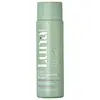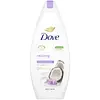Luna Daily The Fragrance Free Everywhere Wash - pH Balanced Body Wash With Prebiotics + Vitamins C & E Versus Dove Relaxing Body Wash
What's inside
What's inside
 Key Ingredients
Key Ingredients

No key ingredients
 Benefits
Benefits

 Concerns
Concerns

 Ingredients Side-by-side
Ingredients Side-by-side

Water
Skin ConditioningCocamidopropyl Betaine
CleansingDecyl Glucoside
CleansingGlycerin
HumectantXanthan Gum
EmulsifyingAloe Barbadensis Leaf Juice
Skin ConditioningSodium Chloride
MaskingLactic Acid
BufferingCoco-Glucoside
CleansingGlyceryl Oleate
EmollientInulin
Skin ConditioningLinoleic Acid
CleansingChamomilla Recutita Flower Extract
MaskingLinolenic Acid
CleansingHydrogenated Palm Glycerides Citrate
EmollientPotassium Sorbate
PreservativeTocopherol
AntioxidantSodium Benzoate
MaskingPanthenol
Skin ConditioningCitric Acid
BufferingSodium Ascorbyl Phosphate
AntioxidantDisodium EDTA
Tocopheryl Acetate
AntioxidantWater, Cocamidopropyl Betaine, Decyl Glucoside, Glycerin, Xanthan Gum, Aloe Barbadensis Leaf Juice, Sodium Chloride, Lactic Acid, Coco-Glucoside, Glyceryl Oleate, Inulin, Linoleic Acid, Chamomilla Recutita Flower Extract, Linolenic Acid, Hydrogenated Palm Glycerides Citrate, Potassium Sorbate, Tocopherol, Sodium Benzoate, Panthenol, Citric Acid, Sodium Ascorbyl Phosphate, Disodium EDTA, Tocopheryl Acetate
Water
Skin ConditioningCocamidopropyl Betaine
CleansingSodium Lauroyl Isethionate
CleansingGlycerin
HumectantSodium Benzoate
MaskingParfum
MaskingSodium Chloride
MaskingCarbomer
Emulsion StabilisingGlycol Distearate
EmollientCaprylyl Glycol
EmollientLauric Acid
CleansingSodium Hydroxide
BufferingStearic Acid
CleansingSodium Lauroyl Glycinate
CleansingPEG-150 Pentaerythrityl Tetrastearate
EmulsifyingSodium Isethionate
CleansingPalmitic Acid
EmollientPPG-6
Skin ConditioningPPG-2 Hydroxyethyl Cocamide
EmulsifyingSodium Gluconate
Skin ConditioningPropylene Glycol
HumectantHydroxystearic Acid
CleansingJasminum Officinale Flower Extract
MaskingCocos Nucifera Fruit Extract
EmollientAlpha-Isomethyl Ionone
PerfumingBenzyl Alcohol
PerfumingBenzyl Salicylate
PerfumingHexyl Cinnamal
PerfumingLimonene
PerfumingLinalool
PerfumingCI 17200
Cosmetic ColorantCI 19140
Cosmetic ColorantWater, Cocamidopropyl Betaine, Sodium Lauroyl Isethionate, Glycerin, Sodium Benzoate, Parfum, Sodium Chloride, Carbomer, Glycol Distearate, Caprylyl Glycol, Lauric Acid, Sodium Hydroxide, Stearic Acid, Sodium Lauroyl Glycinate, PEG-150 Pentaerythrityl Tetrastearate, Sodium Isethionate, Palmitic Acid, PPG-6, PPG-2 Hydroxyethyl Cocamide, Sodium Gluconate, Propylene Glycol, Hydroxystearic Acid, Jasminum Officinale Flower Extract, Cocos Nucifera Fruit Extract, Alpha-Isomethyl Ionone, Benzyl Alcohol, Benzyl Salicylate, Hexyl Cinnamal, Limonene, Linalool, CI 17200, CI 19140
Ingredients Explained
These ingredients are found in both products.
Ingredients higher up in an ingredient list are typically present in a larger amount.
Cocamidopropyl Betaine is a fatty acid created by mixing similar compounds in coconut oil and dimethylaminopropylamine, a compound with two amino groups.
This ingredient is a surfactant and cleanser. It helps gather the dirt, pollutants, and other impurities in your skin to be washed away. It also helps thicken a product and make the texture more creamy.
Being created from coconut oil means Cocamidopropyl Betaine is hydrating for the skin.
While Cocamidopropyl Betaine was believed to be an allergen, a study from 2012 disproved this. It found two compounds in unpure Cocamidopropyl Betaine to be the irritants: aminoamide and 3-dimethylaminopropylamine. High-grade and pure Cocamidopropyl Betaine did not induce allergic reactions during this study.
Learn more about Cocamidopropyl BetaineGlycerin is already naturally found in your skin. It helps moisturize and protect your skin.
A study from 2016 found glycerin to be more effective as a humectant than AHAs and hyaluronic acid.
As a humectant, it helps the skin stay hydrated by pulling moisture to your skin. The low molecular weight of glycerin allows it to pull moisture into the deeper layers of your skin.
Hydrated skin improves your skin barrier; Your skin barrier helps protect against irritants and bacteria.
Glycerin has also been found to have antimicrobial and antiviral properties. Due to these properties, glycerin is often used in wound and burn treatments.
In cosmetics, glycerin is usually derived from plants such as soybean or palm. However, it can also be sourced from animals, such as tallow or animal fat.
This ingredient is organic, colorless, odorless, and non-toxic.
Glycerin is the name for this ingredient in American English. British English uses Glycerol/Glycerine.
Learn more about GlycerinSodium Benzoate is a preservative. It's used in both cosmetic and food products to inhibit the growth of mold and bacteria. It is typically produced synthetically.
Both the US FDA and EU Health Committee have approved the use of sodium benzoate. In the US, levels of 0.1% (of the total product) are allowed.
Sodium benzoate works as a preservative by inhibiting the growth of bacteria inside of cells. It prevents the cell from fermenting a type of sugar using an enzyme called phosphofructokinase.
It is the salt of benzoic acid. Foods containing sodium benzoate include soda, salad dressings, condiments, fruit juices, wines, and snack foods.
Studies for using ascorbic acid and sodium benzoate in cosmetics are lacking, especially in skincare routines with multiple steps.
We always recommend speaking with a professional, such as a dermatologist, if you have any concerns.
Learn more about Sodium BenzoateChances are, you eat sodium chloride every day. Sodium Chloride is also known as table salt.
This ingredient has many purposes in skincare: thickener, emulsifier, and exfoliator.
You'll most likely find this ingredient in cleansers where it is used to create a gel-like texture. As an emulsifier, it also prevents ingredients from separating.
There is much debate on whether this ingredient is comedogenic. The short answer - comedogenic ratings don't tell the whole story. Learn more about comegodenic ratings here.
The concensus about this ingredient causing acne seems to be divided. Research is needed to understand if this ingredient does cause acne.
Scrubs may use salt as the primary exfoliating ingredient.
Learn more about Sodium ChlorideWater. It's the most common cosmetic ingredient of all. You'll usually see it at the top of ingredient lists, meaning that it makes up the largest part of the product.
So why is it so popular? Water most often acts as a solvent - this means that it helps dissolve other ingredients into the formulation.
You'll also recognize water as that liquid we all need to stay alive. If you see this, drink a glass of water. Stay hydrated!
Learn more about Water